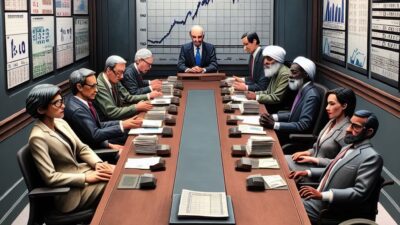Economic Growth Analysis: A Quarter of Progress?
Published on: [Insert date]
Overview of Recent Economic Developments
Recent statistics released by the government reveal that the economy experienced a modest growth rate of 0.1% during the fourth quarter of the year, specifically from October to December. This slight uptick has led to a mixture of cautious optimism and concern among economists, policymakers, and citizens alike, given the myriad of challenges the economy has faced in recent years.
The Significance of a 0.1% Growth Rate
A growth rate of 0.1%, while technically positive, raises several questions regarding the overall health of the economy. In financial terms, such minimal growth may indicate stagnation rather than true recovery. To put this figure into perspective, it is essential to consider the broader economic landscape, including inflation rates, employment figures, and consumer confidence.
For many who rely on economic expansion for job stability and wage increases, this growth could feel more like a pause than progress. The growth rate is an important indicator; however, the implications of such a small increase could signal underlying issues that may impact future economic projections.
Contributing Factors to Economic Growth
Several factors contributed to the slight boost in the economy during this period. Consumer spending played a significant role, with households adjusting their budgets and discretionary spending following earlier economic uncertainties. Additionally, business investments, particularly in technology and renewable energy sectors, helped to bolster economic activity.
Government initiatives aimed at stimulating the economy, such as tax incentives for businesses and increase in public spending, also contributed to the growth. Nevertheless, the impact of these measures can take time to manifest fully in economic statistics, and many experts emphasize the need for sustained growth rather than temporary boosts.
The Challenges Ahead
Despite the slight positive growth, the road ahead for the economy is laden with challenges. Supply chain disruptions, heightened inflation rates, and geopolitical tensions have created an environment of uncertainty. The world’s economy is still grappling with the ramifications of the pandemic, and many sectors are struggling to recover fully.
Inflation remains a significant concern, with rising prices affecting essential goods and services. This can lead to decreased consumer spending power, which is vital for further economic growth. As interest rates rise to combat inflation, borrowing becomes more expensive, potentially resulting in a slowdown in business investments and consumer spending.
Reactions from Economists and Policymakers
The announcement of a 0.1% growth rate has elicited varied reactions from economists and policymakers. Some experts express cautious optimism, viewing the growth as a necessary step towards recovery. “Every bit of growth counts,” says Dr. Emily Anderson, an economist at the National Economic Research Institute. “While 0.1% may seem minimal, it’s a sign that we are moving in the right direction.”
Conversely, other analysts caution against complacency. “We cannot afford to celebrate such a small increase,” warns Dr. Samuel Lee, an economist at the Brookfield Institute. “To rebuild a robust economy, we need to see more substantial and sustained growth over the upcoming quarters.”
The Consumer Perspective
For everyday consumers, the reality of the economy often feels distant from the numbers reported by government agencies. Many individuals report feeling the squeeze of inflation and economic instability in their daily lives. The perceptions of economic growth are not solely determined by statistics but by the lived experiences of citizens.
Marissa Hall, a small business owner, shares her experience: “The cost of goods is rising, and although there is a slight rise in business, it is hard to keep up with the expenses.” This sentiment reflects a broader concern among consumers who are caught between minimal economic growth and rising costs.
Future Expectations: What Lies Ahead?
Looking forward, economists are predicting a challenging landscape for the economy. While the hope is that 0.1% growth in the fourth quarter may lay a foundation for future expansion, several uncertainties loom large. Analysts suggest that successful navigation through these challenges will require effective policy responses and strategic investments.
In particular, government officials may need to consider additional stimulus measures or adjustments to interest rates to encourage broader economic activity. The focus on sectors that can drive sustainable growth, such as technology and green initiatives, may prove vital in shaping the economic recovery.
Conclusion: A Call for Vigilance
In conclusion, the reported economic growth of 0.1% from October to December serves as a reminder of the cautious optimism required when evaluating economic performance. While every increment of growth is significant, it is paramount to remain vigilant and aware of the underlying challenges that could hinder broader recovery efforts.
As the nation moves into the next fiscal period, collaborative efforts between policymakers, businesses, and the workforce will be critical to fostering an environment conducive to sustainable growth. Only time will tell if the slight growth marks the beginning of a more significant economic turnaround.
This HTML document presents an article that analyzes a reported economic growth rate of 0.1% from October to December, elaborating on its implications, challenges, and future expectations in a structured format.











